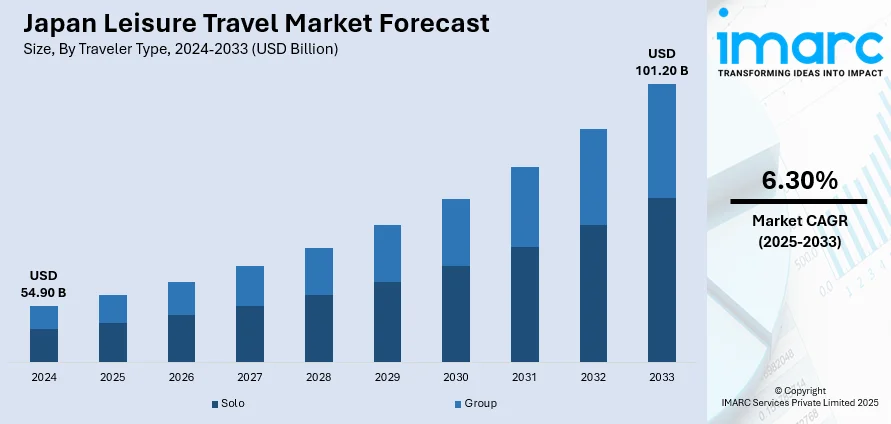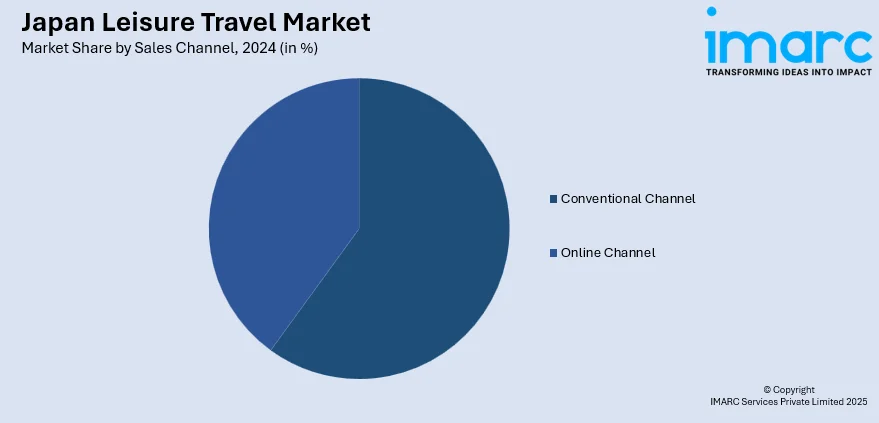
Japan Leisure Travel Market Size, Share, Trends and Forecast by Traveler Type, Age Group, Expenditure Type, Sales Channel, and Region, 2025-2033
Japan Leisure Travel Market Overview:
The Japan leisure travel market size reached USD 54.90 Billion in 2024. Looking forward, IMARC Group expects the market to reach USD 101.20 Billion by 2033, exhibiting a growth rate (CAGR) of 6.30% during 2025-2033. Japan’s leisure travel market is driven by the widespread popularity of its rich cultural heritage, advanced transportation infrastructure, seasonal attractions like cherry blossoms, government-led tourism campaigns, and innovative technological integration, all of which collectively enhance domestic and international tourist experiences while boosting regional economies and promoting sustainable tourism practices across the country.
|
Report Attribute
|
Key Statistics
|
|---|---|
|
Base Year
|
2024 |
|
Forecast Years
|
2025-2033
|
|
Historical Years
|
2019-2024
|
| Market Size in 2024 | USD 54.90 Billion |
| Market Forecast in 2033 | USD 101.20 Billion |
| Market Growth Rate 2025-2033 | 6.30% |
Japan Leisure Travel Market Trends:
Cultural Heritage and Domestic Tourism Promotion
One of the key drivers in Japan's domestic leisure travel market is its vibrant cultural heritage and the government's aggressive promotion of domestic tourism. Japan boasts 25 UNESCO World Heritage Sites, including ancient temples, shrines, castles, and scenic spots like Mount Fuji and historic village houses of Shirakawa-go. These cultural sites draw not only foreign tourists but also tens of millions of domestic tourists trying to reconnect with their heritage, especially during festive and holiday times. The Japanese government has made significant investments in preserving these sites and enhancing tourist experiences through infrastructure upgrades, multilingual signage, and immersive cultural programs. Campaigns such as the "Go To Travel" subsidy program—launched in response to the COVID-19 pandemic—have encouraged domestic travel by offering discounts on transportation, accommodation, and other services. Moreover, cultural events like Kyoto’s Gion Matsuri and Aomori’s Nebuta Festival have become major tourist draws, promoting inter-regional travel and boosting local economies.

Technological Integration and Digital Travel Experiences
Japan’s extensive technological integration in leisure travel experiences is acting as another significant growth-inducing factor. Japan has been at the forefront of the world in terms of robotics, artificial intelligence, and high-speed connectivity—technologies now extensively being utilized to transform the manner in which travelers move about within the country. Smartphone applications offering real-time navigation, travel-recommendation engines that use artificial intelligence, and multilingual voice assistants have revolutionized how travelers plan, book, and experience their journey. Japan's highly advanced rail networks provide smooth and high-speed travel between metropolitan areas, complemented with electronic ticketing and reservation systems. Moreover, intelligent hotels, partly serviced by robots, are a case in point for Japan's hospitality innovations. Technology-facilitated attractions like Tokyo's teamLab Borderless, a digital art museum that is an immersive and interactive experience, are especially favored by younger, technology-friendly travelers looking for futuristic and Instagram-friendly experiences. Virtual reality (VR) and augmented reality (AR) are also being leveraged in heritage sites and museums to create interactive storytelling, merging entertainment and education.
Japan Leisure Travel Market Segmentation:
IMARC Group provides an analysis of the key trends in each segment of the market, along with forecasts at the region/country level for 2025-2033. Our report has categorized the market based on traveler type, age group, expenditure type, and sales channel.
Traveler Type Insights:
- Solo
- Group
The report has provided a detailed breakup and analysis of the market based on the traveler type. This includes solo and group.
Age Group Insights:
- Baby Boomers
- Generation X
- Millennial
- Generation Z
A detailed breakup and analysis of the market based on the age group have also been provided in the report. This includes baby boomers, generation X, millennial, and generation Z.
Expenditure Type Insights:
- Lodging
- Transportation
- Food and Beverages
- Events and Entertainment
- Others
The report has provided a detailed breakup and analysis of the market based on the expenditure type. This includes lodging, transportation, food and beverages, events and entertainment, and others.
Sales Channel Insights:

- Conventional Channel
- Online Channel
A detailed breakup and analysis of the market based on the sales channel have also been provided in the report. This includes conventional channel and online channel.
Regional Insights:
- Kanto Region
- Kansai/Kinki Region
- Central/Chubu Region
- Kyushu-Okinawa Region
- Tohoku Region
- Chugoku Region
- Hokkaido Region
- Shikoku Region
The report has also provided a comprehensive analysis of all the major regional markets, which include Kanto Region, Kansai/Kinki Region, Central/ Chubu Region, Kyushu-Okinawa Region, Tohoku Region, Chugoku Region, Hokkaido Region, and Shikoku Region.
Competitive Landscape:
The market research report has also provided a comprehensive analysis of the competitive landscape. Competitive analysis such as market structure, key player positioning, top winning strategies, competitive dashboard, and company evaluation quadrant has been covered in the report. Also, detailed profiles of all major companies have been provided.
Japan Leisure Travel Market News:
- April 2025: HK Express resumed daily direct flights between Hong Kong and Ishigaki, Japan, enhancing connectivity to Okinawa's scenic destinations. This development is expected to increase travel options, attracting more tourists to the region.
- February 2025: Korean Air announced that it would launch direct flights between Seoul Incheon and Kobe, marking the first international service at Kobe Airport. The airline offered both morning and afternoon departures to accommodate leisure travelers seeking easy access to Japan's Kansai region.
Japan Leisure Travel Market Report Coverage:
| Report Features | Details |
|---|---|
| Base Year of the Analysis | 2024 |
| Historical Period | 2019-2024 |
| Forecast Period | 2025-2033 |
| Units | Billion USD |
| Scope of the Report | Exploration of Historical Trends and Market Outlook, Industry Catalysts and Challenges, Segment-Wise Historical and Future Market Assessment:
|
| Traveler Types Covered | Solo, Group |
| Age Groups Covered | Baby Boomers, Generation X, Millennial, Generation Z |
| Expenditure Types Covered | Lodging, Transportation, Food and Beverages, Events and Entertainment, Others |
| Sales Channels Covered | Conventional Channel, Online Channel |
| Regions Covered | Kanto Region, Kansai/Kinki Region, Central/Chubu Region, Kyushu-Okinawa Region, Tohoku Region, Chugoku Region, Hokkaido Region, Shikoku Region |
| Customization Scope | 10% Free Customization |
| Post-Sale Analyst Support | 10-12 Weeks |
| Delivery Format | PDF and Excel through Email (We can also provide the editable version of the report in PPT/Word format on special request) |
Key Questions Answered in This Report:
- How has the Japan leisure travel market performed so far and how will it perform in the coming years?
- What is the breakup of the Japan leisure travel market on the basis of traveler type?
- What is the breakup of the Japan leisure travel market on the basis of age group?
- What is the breakup of the Japan leisure travel market on the basis of expenditure type?
- What is the breakup of the Japan leisure travel market on the basis of sales channel?
- What are the various stages in the value chain of the Japan leisure travel market?
- What are the key driving factors and challenges in the Japan leisure travel market?
- What is the structure of the Japan leisure travel market and who are the key players?
- What is the degree of competition in the Japan leisure travel market?
Key Benefits for Stakeholders:
- IMARC’s industry report offers a comprehensive quantitative analysis of various market segments, historical and current market trends, market forecasts, and dynamics of the Japan leisure travel market from 2019-2033.
- The research report provides the latest information on the market drivers, challenges, and opportunities in the Japan leisure travel market.
- Porter's five forces analysis assist stakeholders in assessing the impact of new entrants, competitive rivalry, supplier power, buyer power, and the threat of substitution. It helps stakeholders to analyze the level of competition within the Japan leisure travel industry and its attractiveness.
- Competitive landscape allows stakeholders to understand their competitive environment and provides an insight into the current positions of key players in the market.
Need more help?
- Speak to our experienced analysts for insights on the current market scenarios.
- Include additional segments and countries to customize the report as per your requirement.
- Gain an unparalleled competitive advantage in your domain by understanding how to utilize the report and positively impacting your operations and revenue.
- For further assistance, please connect with our analysts.
 Request Customization
Request Customization
 Speak to an Analyst
Speak to an Analyst
 Request Brochure
Request Brochure
 Inquire Before Buying
Inquire Before Buying




.webp)




.webp)












